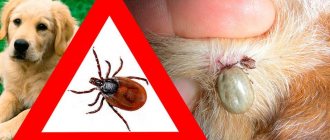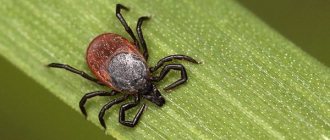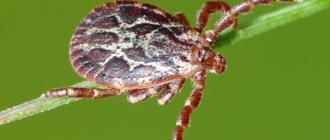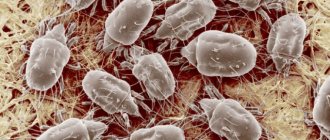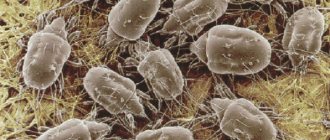Description
In the photo you can see that an adult ixodid tick has a flattened body covered with grooves; the integument is not segmented. In the process of bloodsucking, the chitinous cover is stretched, the body increases significantly in size and its color changes: the body size of a hungry tick ranges from 1 to 7 mm and the color is light yellow, brown or black; after saturation, the size can exceed 25 mm, and the body becomes leaden. gray tint. Sometimes an enamel color of the pigment is observed.
The body of the ixodid tick is divided into a proboscis, which carries the mouthparts, and a trunk with eight limbs. The limbs are walking, each divided into six movable segments, the last of which is represented by a paw with two claws and a suction cup. Well developed. The proboscis can have different lengths; A long proboscis is considered to be one whose length is greater than its width; a short proboscis, accordingly, whose width is greater than its length.
On a note! Depending on the size of the proboscis, ixodid ticks are divided into long- and short-proboscis!
Egg
The egg dimensions are small - about 0.5-1 mm. It has a light yellow or brownish color, with a possible pearl tint.
Larva
The ixodid tick larva lacks one pair of walking limbs and a genital opening. The dorsal shield does not cover the entire body, but only its front part. Being at the larval stage of development, the parasites are already able to feed. A hungry larva is translucent with a brown or yellow color; after saturation, the shade becomes lead-gray.
Nymph
The body structure of the nymph is close to the body structure of the adult. They already have four pairs of walking limbs, but still lack a genital opening. No enamel tint is observed.
Ixodid ticks Ixodidae
The most common pasture tick is the taiga tick, dog tick, forest tick, and dermacentor tick. Outwardly they have some differences, but their lifestyle is no different. The size of a hungry individual is 3 mm. During feeding, the abdomen increases in size, reaching several centimeters in diameter. The colors of a hungry tick are different from those of a well-fed pasture tick. Body color can be gray, brown, red, burgundy, black. Males are always smaller than females. A photo of a pasture tick is presented below.
Species and distribution
Modern science knows more than 650 species of ixodid ticks, which belong to 19 different genera. Of these, representatives of 70 species from 7 genera can be found in Russia. Being parasites of terrestrial vertebrates, these arthropods often choose an animal as a potential host, but many species are also capable of attacking humans.
In the process of evolution, ixodid ticks learned to adapt to a wide variety of living conditions, which is why they became widespread. They can be found on almost all continents, with the only exception being Antarctica. The greatest diversity of species and the most numerous colonies live in the tropics and subtropics. But at the same time, the habitat will always be closely related to the species identity - for example, some ticks exist perfectly in the steppe zone, others - in deserts and semi-deserts, others - in forest-shrub areas, and others live quietly in the mountains. And in each specific zone, parasites always live in certain conditions that will be suitable for the reproduction, development and existence of a particular species.
On a note! For this reason, ixodid ticks are common in pastures in patches - biotopes!
Life cycle
Mating of ixodid ticks often occurs on the body of the carrier, extremely rarely in the external environment, after which the male dies. Upon completion of the saturation process, the fertilized female falls off the host’s body and hides under plant debris or crawls into cracks in the soil. She lays eggs in shelter for one to two months. The number of eggs laid at one time will depend on the species and the portion of blood sucked. Over the course of her entire life, one female is capable of laying about 15,000-20,000 eggs.
On a note! If the fertilized female remains hungry, she will not be able to lay eggs!
- The development cycle of the ixodid tick begins in the egg. The duration of this phase ranges from 2 to 10 weeks, which is influenced by environmental conditions. Eggs are very sensitive to changes in humidity and air temperature - when the humidity drops to 65%, the embryo dies. If the eggs end up in water, embryonic development will slow down and resume again when they are removed from this environment.
- Next, larvae emerge from the eggs, the development of which also largely depends on environmental conditions. At this stage of development, ixodid ticks can stay from 1 to 4 weeks. The larvae spend 2 to 5 days sucking blood, and this process is required for the transition to the next phase. But even in the absence of a constant source of food, they are able to live for a fairly long period of time: from a couple of months to one or two years.
- Development in the nymphal phase can last from 1 to 5 weeks. Nutrition at this stage takes a slightly longer period of time and ranges from 3 to 8 days.
- The adult stage completes the cycle.
Features of biology
Ixodid ticks are mostly lurking blood-sucking parasites, which are divided into grazing and burrowing. The first ones wait for a potential host in an open space, sitting on the grass or on the leaves of a bush, from where they then attack. The disappearance of these bloodsuckers occurs under the same conditions. Burrow mites prefer to “hunt” in shelters, and the degree of their attachment to burrows will depend on the species.
Ixodid ticks are divided into groups depending on the characteristics of their life cycle:
- Representatives of species characterized by a single-host life cycle feed on the body of their host, experiencing three phases of their development: larvae, nymphs and adults. In this case, a engorged adult leaves the host’s body and goes off to lay eggs.
- Ticks with a two-host cycle are characterized by feeding at the larval and nymph stages. The latter disappears at the end of its phase. The host can be one species or something close to it.
- Ixodid ticks of animals with a three-host life cycle remain on the host’s body exclusively during the period of blood sucking. At the same time, burrowing parasites choose only one species for feeding, while grazing parasites choose different species: larvae and nymphs parasitize mainly small mammals or reptiles, and adult individuals attack larger animals.
Types of ticks and symptoms
Common types of ticks in different regions of the country:
Four-legged garlic
Four-legged garlic (Aceria tulipae). The body does not exceed 0.26 mm in length. Parasitizes daylilies, onions, tulips, and garlic. Often moves to vegetating surrounding crops.
Signs of defeat. The stem and leaves are covered with a white coating. Yellow spots appear on the leaves and bulbs, which turn into rot and mold. The plant becomes dehydrated and dries out.
Pictured is a four-legged garlic mite
Onion root
Onion root (Rhizoglyphus echinopus). Individuals of yellow and white color reach a size of 0.7-1.2 mm. They quickly spread throughout plants, penetrate the stem and establish colonies. Garden and vegetable crops are affected.
Signs of defeat. The plant loses its elasticity and dries out. Yellow and brown spots in the root part gradually become a colony for fungi. Rot and black mold develop on deformed fabrics. Seedlings attacked by the pest rarely survive to the phase of active growth and development. A person who comes into contact with a diseased plant develops atopic dermatitis, scabies, and asthma.
Pictured is an onion root mite
Putrid elongated
Putrescent elongated (Tyroglyphus putrescentiae). The habitats of this variety are vegetable stores, warehouses and cellars where bulbs and tubers are stored. It looks like Rhizoglyphus echinopus, but its habitat is much wider: it destroys seedlings of aster, dahlia, cucumbers, and grapes.
This variety of onion mite parasitizes colonies of oyster mushrooms, champignons and other home-grown mushrooms. They actively feed on processed grain products, groceries and cheese products. Causes food allergies and anaphylactic shock.
Signs of defeat. Tubers, bulbs, leaves attacked by the parasite are instantly covered with rot and mold of various types.
In the photo there is a putrefactive elongated mite
Maliciousness
Ixodid ticks feed exclusively on blood and can parasitize humans, as well as both wild and domestic animals. The danger from contact with them is that they are capable of carrying many pathogens of quite serious diseases.
On a note! During a bite, an infected ixodid tick, along with salivary secretions, transmits the virus to its owner, which certainly enters the blood!
Danger to humans
On the territory of the Russian Federation, there are two species of ixodid ticks, which are carriers of tick-borne encephalitis and Lyme disease. In this case, the danger comes from ticks of the genus Ixodes: Ricinus (dog) and Persulcatus (taiga).
Also, the ixodid tick can provoke the development of diseases such as:
- relapsing fever;
- typhus;
- tularemia;
- paroxysmal rickettsiosis;
- hemorrhagic fever;
- Marseilles fever;
- Q fever
In this case, the virus is able to penetrate the body even when an infected tick is crushed. For this reason, attempting to kill an adult with bare hands is highly discouraged. But here you should know that an ixodid tick bite will not always result in a disease. People with high levels of interferon and those who have been vaccinated are excluded from the risk group.
Danger to animals
In dogs, ixodid ticks can provoke the development of such serious diseases as piroplasmosis, helminthiasis, as well as various bacterial infections. The situation is aggravated by the fact that the dog itself does not feel the bite, and therefore it is not possible to correct the situation immediately before it gets worse. The only symptom may be an allergic reaction. If the animal does not have such a tendency, then, most likely, the bloodsucker will remain unnoticed. And the further it goes into the skin, the larger its size becomes and the more rapidly the risk of infection increases.
Ixodid ticks are also not uncommon in cats and, unfortunately, can cause considerable harm to their health. And if the dog does not feel the bite of the parasite and does not react to it in any way, then the cat, on the contrary, begins to actively itch. This is due to the fact that the secretion secreted by the bloodsucker provokes itching in the animal. And in this case, it is scratching that is dangerous, since in the process the cat can simply tear off the body of the tick, leaving its head in the skin. And this is fraught with the development of suppuration, sometimes sepsis.
Interesting facts about ticks
Despite the fact that our article was devoted to such parasites as ticks, it would be useful to present interesting facts about their existence at the end of the consideration of these pests.
This is interesting:
- these parasites are arachnid mites, in other words, they are closer in kinship to scorpions and spiders, and not to insects;
- mites are characterized by 4 phases: eggs, larvae, nymphs and adults;
- about 850 species of ticks are known;
- these parasites feed on the blood of their victim;
- the tick may appear as a small dark spot on the animal’s skin;
- dogs are more likely to become infected with ticks than cats;
- Newly born ticks for the most part are not carriers of diseases; they get them by parasitizing their victims;
- animals can become infected with several diseases from one bite;
- The most common carrier of canine diseases is the dog brown tick; about treating a dog for ticks, read the article “Which tick remedy for dogs should I choose?”;
- You should never remove the parasite with your bare hands, but rather, grab the tick with tongs and carefully remove it;
- To the question - how long does a tick live, you can give a definite answer, up to several years, even in the complete absence of food.
It should be noted that virtually every type of tick has the potential to cause harm to humans, if not to health and body, then to food and the environment.
Fighting methods
To combat ixodid ticks, it is customary to use pesticides and insecticides. These products may have different principles of action and release forms.
Acaricides
Repellents are usually used to repel parasites. They are applied to outer clothing to avoid contact with the bloodsucker while walking or relaxing in nature. The duration of action of such drugs can be several days. Among the popular acaricides:
- "Biban" is based on diethyltoluamide. The drug can be applied to the body, clothing, curtains and mosquito nets. When using, you should be careful and avoid getting the product on the mucous membranes or inside.
- "Gardex" - the active substance exhibits a paralyzing effect and for this it is enough for the tick to come into contact with treated clothing. This product is not applied to open areas of skin. The Gardex aerosol works for a long time and provides protection against bloodsuckers for two weeks.
- “Cifox” - this product is available in the form of an emulsion based on cypermethrin. Shows high efficiency in the destruction of blood-sucking individuals. Does not have a repellent effect. When applied to clothing, it provides protection for two weeks, in the home – for 2-3 months.
Industrial animal protection products
The fight against ixodid ticks in animals is carried out using means that have contact activity. These include:
- “Leopard” - drops on the withers, spray;
- “Butox” is an emulsifying concentrate that can be treated by bathing the animal and by spraying;
- "Neostomozan" - used in breeding for bathing, wetting or spraying animals;
- “Dana” spray and drops on the withers;
- “Demos-Lux” is a pet shampoo, and it can be used not only for adult animals, but also for kittens and puppies.
In general, in order to avoid troubles associated with an attack by ixodid ticks, it is necessary to carry out simple prevention. First of all, it is associated with the use of repellents that will repel bloodsuckers while walking in the fresh air. If you live in a private house or spend the summer in a suburban area, then take care of timely cleaning of the area from excess vegetation and dead wood. Plus, it is advisable to regularly examine your pet’s body, ideally after each visit to the street. If a tick is found, it should be removed very carefully so as not to leave the head under the skin. If the animal's health deteriorates, it should be immediately taken to a veterinary clinic.
Tick, who is he?
Ticks are small arthropod insects belonging to the class of arachnids. When you go on vacation in nature, you run the risk of encountering a very common representative of these insects - the ixodid tick. The ixodid tick family includes about 680 species, among which the European forest tick (Ixodes Ricinus) and taiga tick (Ixodes Persulcatus) are a real problem.
Hatching from the egg, the forest tick goes through three stages of development:
- larva (0.5 mm);
- nymph (1.5 mm);
- adult (about 3 mm – male, 4 mm – female).
The female's hind coverings can stretch greatly, allowing her to absorb more than a hundred times her weight in blood. Males do not attach for long. Ticks can smell a person or animal at a distance of about 10 meters.
Ticks prefer moist, moderately shaded places: the bottom of ravines, thick grass on the edges of forests, and the like. Maximum insect activity occurs at the end of April – beginning of July.
What is Lyme disease?
Lyme disease (tick-borne borreliosis) is caused by Borrelia shed in tick feces. Infection of humans occurs relatively rarely, although the infection rate of the ticks themselves can reach 100%.
Once in the body, borrelia may not show their presence for years. As a result, this leads to a delayed onset of the disease, its chronic course or relapses.
From the moment of the bite until the symptoms appear, it can take from 2 to 30 days. First, as a rule, there is the formation of a growing red spot (up to 10 cm in diameter, and sometimes more), but this is not guaranteed at the site of the bite. Gradually, the shape of the spot changes to a ring-shaped one. It disappears on its own after a few days, and after one to a month and a half, signs of damage to the heart, nervous and skeletal system appear. Also, after some time, similar spots with a different localization (“erythema migrans”) may appear. It is worth remembering that tick saliva can cause redness of the skin, which is not erythema migrans and resolves within two days. The acute onset of Lyme disease is characterized by high fever and signs of meningoencephalitis.
